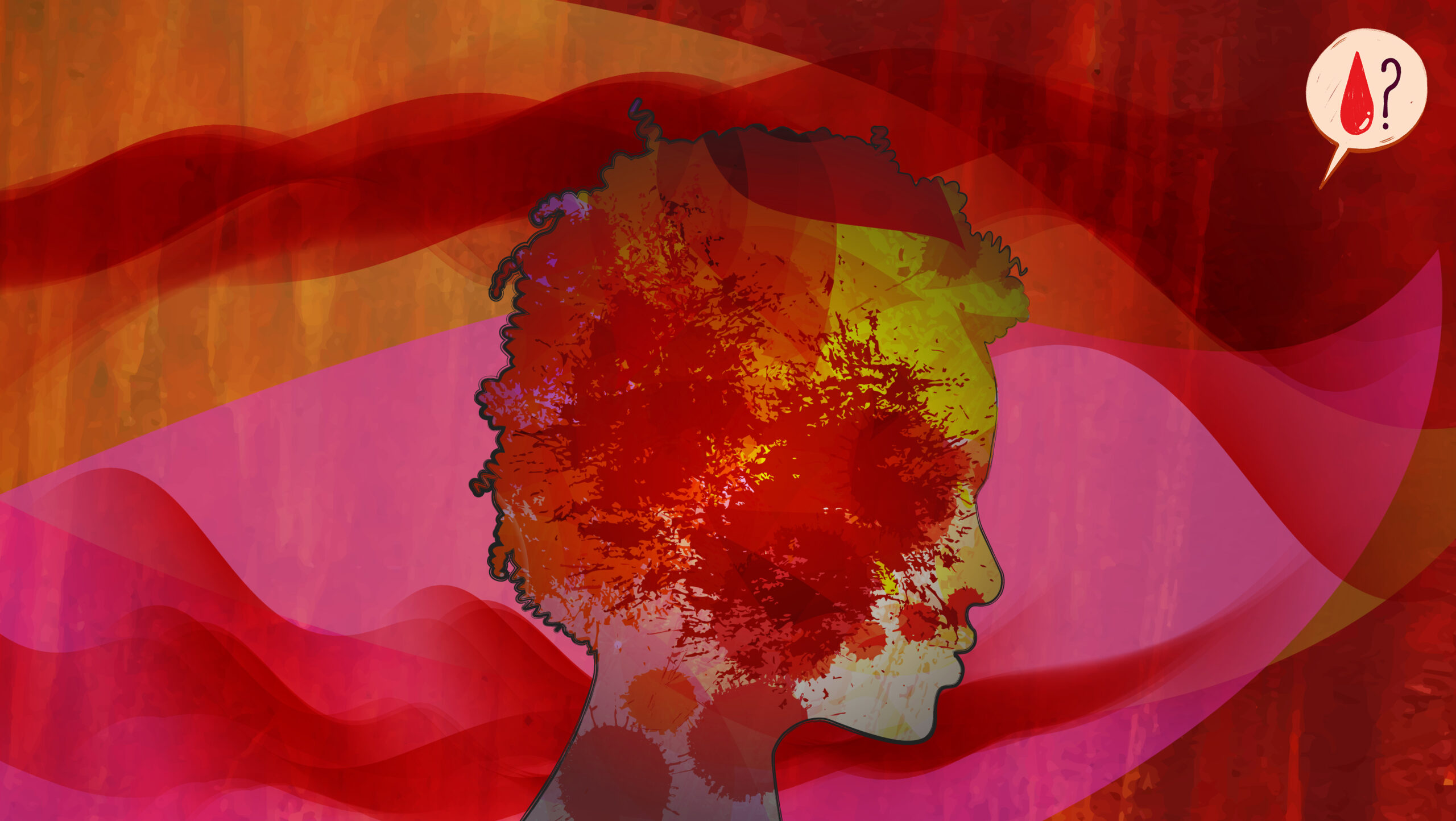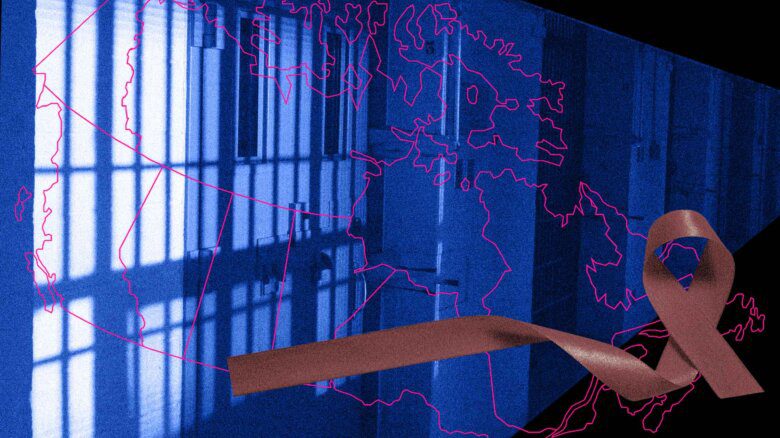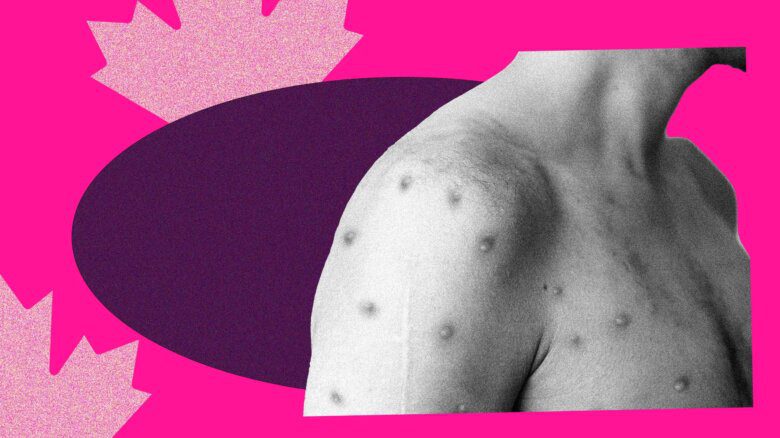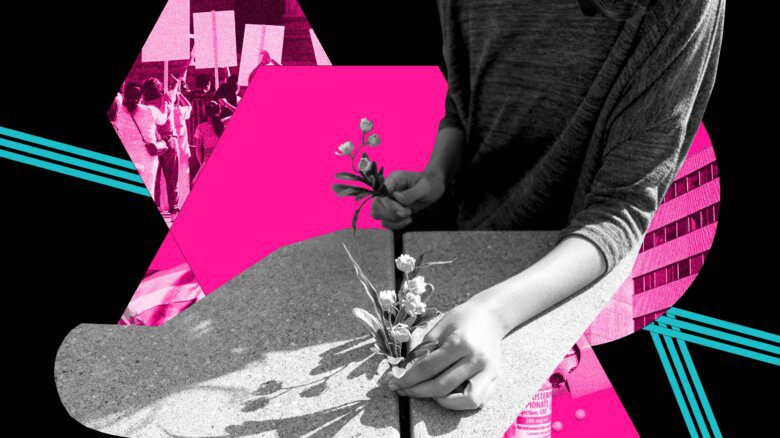This story is part of Seeing Red, a month-long series exploring periods from an LGBTQ2 perspective.
“I would be angry if I were you,” she says, so quietly that I have to ask her to repeat herself. She’s the white sonographer, and I’m the one with legs wide for my at-long-last transvaginal ultrasound. It’s October 2017; we’re in a rural hospital in southwestern Pennsylvania and I’ve seen no other Black person on the long bus ride a county away or in the hospital itself. No other Black queers, that’s for sure. I’m here because I finally found someone — the referring gynecologist a town away — to take me and my pain seriously.
“Your uterus is just one big fibroid,” the sonographer almost gasps, then tells me that the standard-practice ultrasound I’m getting now would have detected this ages ago. Which is another way of saying that I could have been easily spared months of debilitating pain, tennis ball–sized blood clots, anemic fatigue and periods that seemed to start up again as soon as they ended.
“I mean, your uterus is overtaken by fibroids. Have you ever tried getting pregnant?” the sonographer continues, presumably because she would be surprised if I could do so or carry a baby to term. I had never tried or wanted to be pregnant, but it felt strange to have its implausibility dictated by something other than my choice.
“I don’t know why all this wasn’t caught earlier,” she says finally. I wonder the same thing — after all, my period had been gradually worsening since 2013, when I was 37 years old. But I don’t share her supposed innocence. I am a Black woman, and I know to file this away in the annals of medical misogynoir.
Black queer feminist scholar Moya Bailey coined “misogynoir” in 2010 to capture the cocktail of racism and misogyny that Black women face — and that includes in the healthcare system. Even a Black mother as resourced as Serena Williams could not escape having her breathing troubles dismissed after she gave birth to her daughter in 2017; it was she who, having almost died of a pulmonary embolism in 2011, had to insist repeatedly to her medical team that she had yet another blood clot in her lung.
Although a tangled web of factors and social determinants of health are responsible for Black maternal mortality rates, misogynoir is undoubtedly implicated in the fact that Black women are three to four times more likely to die of pregnancy-related causes than their white counterparts. Pelvic pain infections and diseases like endometriosis — which can lead to ectopic pregnancy and painful growths — affect Black women at a higher rate, though they are more likely than white women to be misdiagnosed. Black women are also more than twice as likely to die of endometrial cancer than other racial and ethnic groups. Racial bias in the healthcare system — and the corresponding undertreatment of Black pain, especially for Black women — have been documented in numerous studies.
“Black women’s pain has been a foot soldier in the march of medical progress, but too often, it’s not deemed important enough to alleviate.”
Misogynoir is even inseparable from the founding of modern gynecology. In 1840s, J Marion Sims subjected Anarcha Wescott, Betsey Harris, Lucy Zimmerman and other enslaved women to gynecological experiments without anesthesia. After all, this “father of modern gynecology” and eventual president of the American Medical Association believed Black people were less sensitive to pain. In 1951, a Black tobacco farmer named Henrietta Lacks walked into John Hopkins Hospital in Baltimore — and into medical history. Her visit, prompted by vaginal bleeding and abdominal pain, led to a cervical cancer diagnosis. Samples from her cervix — taken without her knowledge, and without her consent — are the origin of the world’s first immortalized cell line. This cell line was dubbed “HeLa,” after the first two letters of Henrietta Lacks’ name. HeLa cells were and continue to be key in biomedical advances such as the polio vaccine, gene mapping, cloning, and in vitro fertilization.
Black women’s pain has been a foot soldier in the march of medical progress, but too often, it’s not deemed important enough to alleviate. That was true for me — at a women’s clinic in February 2017, the nurse practitioner who administered my PAP smear seemed unmoved when I mentioned my exceedingly painful periods. She confessed that she couldn’t do a thorough examination because, in her words, “the shape of your uterus is abnormal.” Which, as I learned from my gynecologist months later, displayed a lack of due diligence on the nurse practitioner’s part. My swollen uterus ended up explaining the pain and heavy bleeding, after all.
Seven months before that ultrasound in the fall of 2017, on a rainy March afternoon, I was bedridden with period pain for days. At the time, I didn’t know that I had fibroids, even though Black women are three times more likely to have fibroids than white women are. I had already tried Pamprin, Midol, Motrin, Aleve, Tylenol-Codeine, Vicodin, muscle relaxers. Walking. Not walking. Yoga poses. Raspberry leaf tea, harvested by a herbalist friend. Commercial teas for menstrual pain. Heating pad. Icy hot patches. A clary sage oil blend rubbed on my belly. Sleep, that usually trusty haven, didn’t do the trick either because the relentless stabbing sensation in my pelvic area would tear through my rest. Heavy bleeding also meant I had to get up throughout the night to put on yet another pair of adult diapers — along with several cloth pads I had fashioned from old towels. I was ready to dig out my uterus with a rusty spoon.
I already knew that these remedies were insufficient. My friend Mari*, a queer Black doctor who was then working at John Hopkins — the same hospital that had appropriated Lacks’ cells almost 70 years ago — had told me that a parade of painkillers to deal with my period was not normal. She was the first person to suggest this pain wasn’t something that I simply had to live with. While affirming, I was somewhat at a loss about what to do with this information. I mean, I had tried getting help at that women’s clinic to no avail.
But that March afternoon, this implacable anguish and pain made me feel hopeless, breathless and tunnel-visioned. I cried — surprising myself, since I had never shed tears over physical pain. I called Lisa Cunningham, an educator and mentor of sexual and spiritual health and a fellow queer Black woman, to express my concern. She told me to go to the emergency room immediately — that it could be a ruptured ovarian cyst. “And make sure they do an ultrasound,” she said. “You might need a hysterectomy.” I could barely process that possibility.
I hobbled three blocks to the hospital, and after waiting for what seemed like hours, I was hooked up to an IV of pain medication that vaporized the stabbing sensations in my pelvis. The nurse said that while it was effective for pelvic floor pain, I couldn’t get a prescription: it was too expensive for a script and was only for short-term use.
The doctor came in and said I would be getting a prescription instead for ibuprofen. Having had no relief with the drug before, I asked if I could have something stronger. He shook his head. “Ibuprofen is the same as what you’re getting in the IV now,” he said. I knew he was lying — the nurse had told me otherwise and, more importantly, so had my own body. This felt like gynecological gaslighting. And it felt like yet another dismissal of Black pain. But the doctor chalked my torment up to “just cramps,” with no real follow-up recommendations, and sent me on my way with my ineffective ibuprofen.
“As usual, queer affinity networks affirmed me before institutional medicine would or could.”
Months later, while on vacation with my then-girlfriend, I started bleeding profusely. I bled so heavily and quickly that I couldn’t even stand. I get rushed to ER again, and this time, I was not just handed a useless prescription; I got connected to a gynecologist who finally found my symptoms troubling, and started immediately treating my low iron levels. She ordered the transvaginal ultrasound that I had in that rural hospital in southwestern PA where I found myself, legs wide, as the white sonographer told me in disbelief that my uterus was full of fibroids. And, it turned out, I needed a hysterectomy.
Jan 25, 2018 was the day of my hysterectomy — and what felt like my own Emancipation Day. The surgeon said the fibroids were benign. He also successfully removed bladder and rectal endometriosis, which required the removal of my left ovary. He also said my uterus was 12 times the normal size. Until now, doctors and nurses had treated my intense pelvic pain as nothing more than run-of-the-mill menstrual cramps. And for years, it was my squad of other Black queer women who had warned me it was much more.
As usual, queer affinity networks affirmed me before institutional medicine would or could. My friends knew that healthcare systems didn’t consider us experts of our own pain and experiences, so we had to validate each other. These networks of adopted kin are especially important as we might also be estranged from our families of origin.
“My own tenacity and Black queer solidarity ended up radically improving my quality of life.”
I am so grateful for the science and sisterhood of the queer Black women in my life. After all, it was Lisa who told me that I’d need a hysterectomy; Mari who told me that my pain was not normal; and Liya* , another Black queer woman, who suggested my preoccupation with ice — which I often craved more than food — could signal anemia. (Big surprise: a doctor ended up diagnosing me months later).
My group of friends also taught me that my greatest advocate for my health was me — especially as a queer Black woman. As Lisa Cunningham told me, “Healthcare generally is about access — and then having the patience, the perseverance and the ability to advocate for yourself. This is hard enough under the best of circumstances, but what if you’re not straight? What if your birth gender assignment is wrong? What if the pain is physical and mental? If they won’t hear you when it hurts, how will they hear you through all those other complexifying aspects to our identity? There’s an easily googleable history of POC being perceived by some as not feeling pain as acutely as other races do. Add these ‘other’ ingredients and the access gets further and further away.”
Such access had eluded me for four years, but my self-advocacy increased as my symptoms worsened; my own tenacity and Black queer solidarity ended up radically improving my quality of life. No matter how past or present medical misogynoir may beg to differ, my Black queer life is a life worth saving — and savouring.
*Names have been changed.

This story is part of Seeing Red, a month-long series exploring periods from an LGBTQ2 perspective.


 Why you can trust Xtra
Why you can trust Xtra


